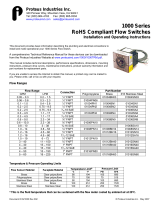
6 Accessories
Part number Description
23747-06 Interconnecting cable, Variopol (VP) 6, 2.5 ft. (0.8 m)
23747-04 Interconnecting cable, VP 6, 4 ft. (1.2 m)
23747-02 Interconnecting cable, VP 6, 10 ft. (3.0 m)
23747-07 Interconnecting cable, VP 6, 15 ft. (4.6 m)
23747-08 Interconnecting cable, VP 6, 20 ft. (6.1 m)
23747-09 Interconnecting cable, VP 6, 25 ft. (7.6 m)
23747-10 Interconnecting cable, VP 6, 30 ft. (9.1 m)
23747-03 Interconnecting cable, VP 6, 50 ft. (15.2 m)
23747-11 Interconnecting cable, VP 6, 100 ft. (30.5 m)
23567-00 1½-in. flow through tee with 1½-in. socket connections
915240-03 2-in. flow through tee with ¾-in. female national pipe
thread (FNPT) connections
915240-04 2-in. flow through tee with 1-in. FNPT connections
915240-05 2-in. flow through tee with 1½-in. FNPT connections
24091-00 Low flow cell with ¼-in. OD tubing compression fittings
9390004 Rotameter: 0.5 - 5.0 gph
22550-00 Junction box, 12 terminals
9200266 Extension cable for option -54, unterminated (specify
length)
9200275 Extension cable for optimum EMI/RFI cable,
unterminated (specify length)
23747-00 Extension cable for optimum EMI/RFI cable, terminated
(specify length)
2001492 Stainless steel tag
23501-11 Dissolved ozone membrane assembly; includes 1
membrane assembly and 1 O-ring
23502-11 Dissolved ozone membrane assembly; includes 3
membrane assemblies and 3 O-rings
9210299 #3 Dissolved ozone sensor fill solution, 4 oz (125 ml)
33521-02 Membrane retainer
33523-03 Fill plug
Quick Start Guide November 2019
20 Emerson.com/Rosemount






















